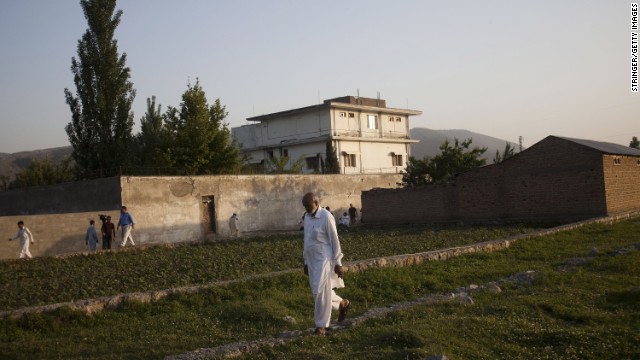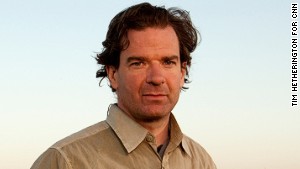May 03, 2012
A Visit to Osama bin Laden’s Lair
A visit to Osama bin Laden's lair
By Peter Bergen, CNN National Security Analyst
May 3, 2012 -- Updated 1137 GMT (1937 HKT)

A local man walks through a field near Osama Bin Laden's compound, where he was killed during a raid by U.S. special forces a year ago.
STORY HIGHLIGHTS
- Peter Bergen was only journalist to visit place where bin Laden lived -- and died
- Bergen says the squalid compound seemed like a camping site
- Bin Laden's room still contained medicines and hair dye he used
- From this site, bin Laden composed memos in effort to control al Qaeda, Bergen says

Peter Bergen
In the bedroom in which al-Qaeda's leader finally was killed, I had expected a frisson of something; perhaps a sensation like exploring Hitler's bunker complex beneath the streets of Berlin at the end of World War II. Instead, I felt only a mild curiosity. On a shelf in bin Laden's bedroom was a box of Just For Men hair dye; in the final years of his life bin Laden dyed his hair and beard jet black to maintain a youthful appearance. I also noticed some medicines like ampicillin, ibuprofen, Nestle energy glucose strips, Amplicox (a penicillin) and Spasler P syrup, which has an antispasmodic effect on the muscles of the gastrointestinal and urogenital tracts. I examined bin Laden's tiny bathroom, about the size of a closet, and noticed that he used a toilet that was really only a hole in the floor over which he had to squat to do his business. It's not the image that one usually associates with the world's most wanted man. Next door to the bedroom, which he shared with his much younger Yemeni wife, was bin Laden's study. Crude bookshelves lined the walls and another large window overlooked the enclosed terrace. It was here that bin Laden composed often mammoth memos to his key lieutenants as he sought to maintain some measure of control over his organization, which was now under intense assault by the United States and its allies. Some of these memos are being released on Thursday by West Point. * * * In February I secured permission to enter Osama bin Laden's compound in the northern Pakistani city of Abbottabad, where he was killed and where he had lived for the last half-decade of his life; the first, and only, journalist to do so. I was escorted by officers of Pakistan's military intelligence agency, ISI, past checkpoints manned by armed soldiers who were there to dissuade the merely curious from approaching the compound. Arriving at the front gate of the bin Laden residence, we were joined by a Pakistani Army captain wearing a sidearm. He would be our escort. I had been instructed "no photographs." Clearly, this rule would be enforced were it to become necessary. We entered through the main metal gate of the compound, which opened onto an internal narrow street with high walls on both sides. We then turned right into a small field, around a third of an acre in size, where the residents of the compound grew crops. This field was enclosed by the compound's walls on three sides, and on one of the sides there was a small storage shack for the harvested crops. I could see burn marks on one of the outer walls of the compound where the tail rotor of a helicopter had clipped the wall and broken off. It was the stealth Black Hawk helicopter that had developed mechanical problems during the U.S. Navy SEAL raid that killed bin Laden. There were also burn marks in the field where the downed chopper was subsequently blown up by the SEALs as the raid was ending. On the other side of the compound were concrete feeding pens where the residents kept cows. Beyond that was a large garden where they grew vegetables such as cucumbers. In the vegetable garden there was a small "hujra" structure that functioned as a sitting room and that was littered with cardboard boxes for computer equipment. The bin Ladens also kept honeybees and rabbits. On the ground there were scattered cartons of Quaker Oats and large empty cans of Sasso olive oil. On one side of the compound was a self-contained, walled-off annex area. This is where bin Laden's trusted courier, Ahmed al-Kuwaiti, lived with his wife and four children. In this annex area was a simple garage where bin Laden's courier parked his white jeep and red van. Inside the courier's one-story house, all the rooms were small and simple. They consisted of a washroom with a shower, a kitchen, a bedroom and a storage room. Children's toys were scattered around the floors of this building and children's bikes were parked in the storage area. There were medicine bottles and cough syrup on shelves in the bathroom and a calendar in the kitchen that marked Ramadan eating and prayer times. Follow @CNNOpinion on Twitter On the night of the raid, Pakistani officials found the courier's body lying just outside his bedroom and behind a locked grey door with windows that had been shot out. The courier was killed with two bullets to the chin and his wife, Mariam, was shot and wounded. The Pakistani intelligence official guiding me through the compound said there were no AK-47 bullets found at the scene and he therefore surmised that the courier had been taken by surprise and was shot before he could reach for his AK-47, which was recovered leaning against the wall of the Kuwaitis' bedroom. Leaving this annex area we passed through a metal door in an internal compound wall and came into a pleasant lawn area, in the middle of which was a small structure that was used by the residents as a sun room. Next to this was a water tank and a bread oven. Dominating the lawn was the three-story house in which bin Laden lived with his three wives and a dozen of his children and grandchildren. We entered the front door of the house. On the right was a study and on the left a bedroom. On the door of this room I saw graffiti, which turned out to be verses of the Quran. It was in this room where, after the raid, Pakistani officials found the courier's brother and his wife, both shot dead. Officials also found about a dozen children with their hands tied together in this ground floor bedroom. Deeper into the house was a kitchen and two sizable storage rooms. At the back end of the ground floor was a room where the bin Laden family would watch the sole TV in the compound. In this room was a gas heater that had an improvised exhaust system attached to it made from bits of sheet metal hammered together. At the back of the house was the stairwell. Blocking the way up the stairs was a massive yellow iron metal door that sealed off access to the upper two floors of the house. This gate had large blast marks on it where the SEALs forced their way through as they closed in on bin Laden. Halfway between the ground floor and the second floor, Pakistani officials found the body of Khalid bin Laden, bin Laden's 23-year-old son, who was shot and killed by the SEALs on the staircase. The SEALs shot to kill or wound most of the adults they encountered in the compound, killing four men, one woman and wounding two other women. Of the 11 adults on the compound (which included three of bin Laden's adult children: Khalid, 23, Mariam, 20, and Summiya,18) they shot seven of them. They did not shoot at bin Laden's two older wives. On the second floor of the compound were rooms for the older wives and for his various children and grandchildren. Their beds were made from plywood boards hammered together. As on the previous floor, there was an improvised system of metal pipes to remove the exhaust from a gas heater. In the kitchen of each wife's area there was a similar improvised exhaust system made from sheet metal to expel kitchen smells. The overall effect of all this was of a long-term but makeshift camping site and the overwhelming impression I had was one of squalor. Medicines for indigestion and other ailments littered the floor and there was a large amount of broken glass everywhere, testament to the intensity of the SEAL assault on the compound. This second floor had a terrace from which there was a lovely view of snow-capped mountains. From this terrace one could look down to an area where a guard dog was once tied and there was a coop for chickens. In the area where the chickens were kept I noticed several computer keyboards strewn about, presumably left there as the SEALs hurriedly carted off much of bin Laden's computer equipment. The image we have of bin Laden in his final years in Abbottabad is of an aging man with a graying beard watching old footage of himself; just another suburban dad flipping though the channels with his remote. And in the end, bin Laden died in a squalid suburban compound surrounded by his wives and children and far from the front lines of his holy war.
FEATURED BOOK

